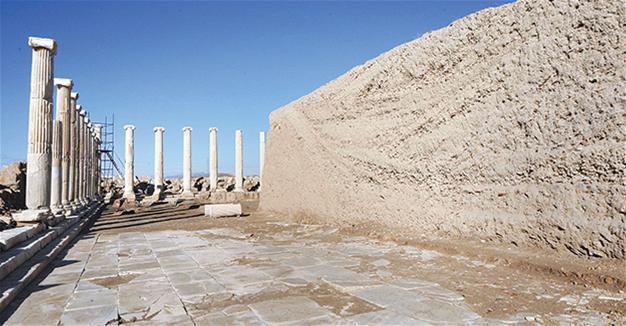Sacred agora unearthed in Laodicea
DENİZLİ - Doğan News Agency

DHA photo
Archaeological excavations in the ancient city of Laodicea, located in the Eskihisar neighborhood in the western province of Denizli and added to the UNESCO World Heritage Temporary list in 2013, are continuing at a 10-meter-long sacred Agora on an area of 35,000 square meters.
Celal Şimşek, the head of the Laodecia excavations and of Pamukkale University’s (PAU) Archaeology Department, said they would bring the “site back to its original state of 2,000 years ago.”
Excavations and restorations have been ongoing in the ancient city for 13 years and the team is focused on restoration works in the sacred agora and western theater this year.
Şimşek said works carried out in the ancient city increased the city’s attraction.
“Laodicea will become one of the world’s most popular places to see in the next three or four years. It has lots of archaeological material. The northern sacred agora is the only one in the world. The revival of the 100-meter-long and 11-meter-high wall in the back, which is covered with paintings, is particularly important for world archaeology. The roof tiles here will also be restored to their original state,” he added.
Removed from seven meters underground
The agora is the largest sacred field in Anatolia due to the temple there, according to Şimşek, who said the sacred agora collapsed during an earthquake in 494 A.D. and was unearthed from seven-meter underground.
“Work in the agora is very important. It covers an area of 35,000 square meters. There is 10.8-meter columned gallery here that we call the portico. We have revived huge columned galleries, and there were ruins of buildings that have collapsed in earthquakes since the 4th century,” he said.
“We have found sculpture heads, jewelry, and ceramic pots and pans in these ruins. This year we made restorations of 34 columns in the southern and western portico of the agora and we plan to revive the structure of 2,000 years ago to its original state,” Şimşek added.
“In the Hellenistic theater, which we call the western theater, we have initiated works at the stage structure. We plan to open this theater to the use of Denizli and our country in two years. The first floor of the stage structure survives entirely and the second floor survives partially. There are very beautiful reliefs in the theater and we know that the stage had been decorated with sculptures. Pieces of the sculptures have been found, and we know that the stage structure was used as a city wall in the 5th century when the city was narrowed,” he said.
This year alone 256 artifacts have been removed and delivered to the local museum from the ancient site, worked on by a team of 120, including 16 academics, 15 archaeologists, six restorers and two architects. The team also has 362 artifacts in hand, Şimşek said.
